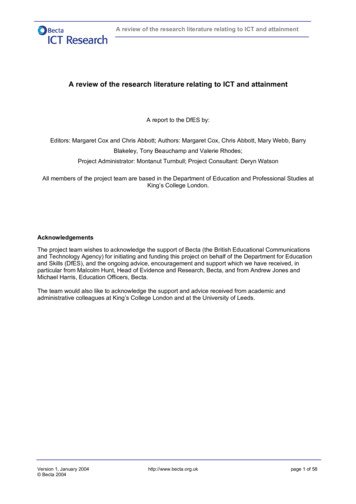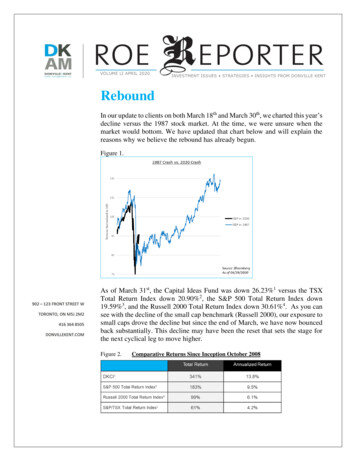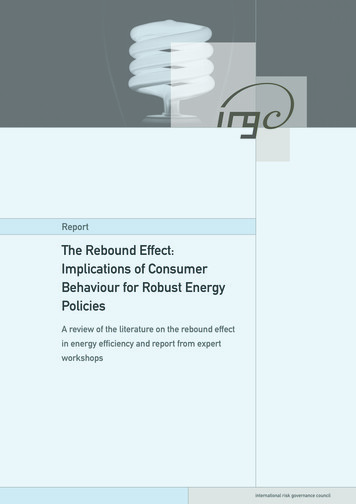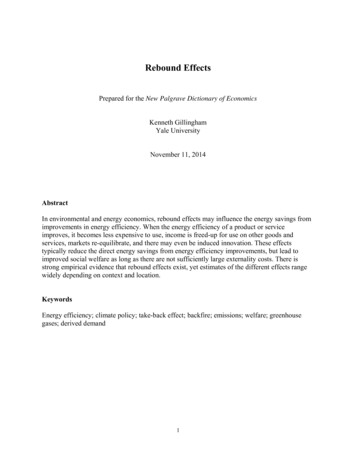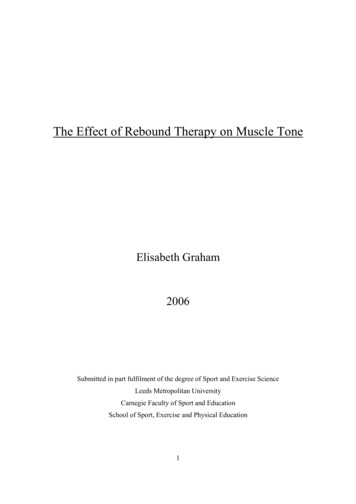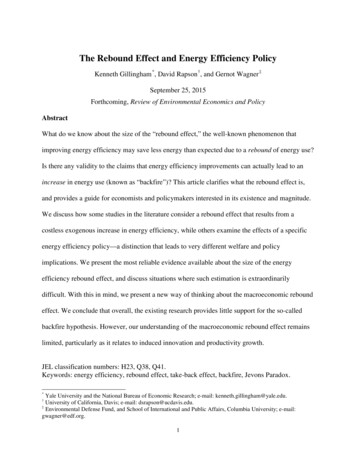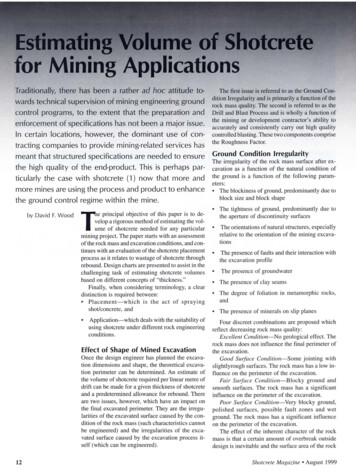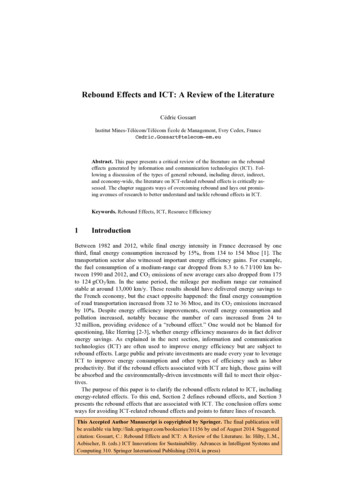
Transcription
Rebound Effects and ICT: A Review of the LiteratureCédric GossartInstitut Mines-Télécom/Télécom École de Management, Evry Cedex, FranceCedric.Gossart@telecom-em.euAbstract. This paper presents a critical review of the literature on the reboundeffects generated by information and communication technologies (ICT). Following a discussion of the types of general rebound, including direct, indirect,and economy-wide, the literature on ICT-related rebound effects is critically assessed. The chapter suggests ways of overcoming rebound and lays out promising avenues of research to better understand and tackle rebound effects in ICT.Keywords. Rebound Effects, ICT, Resource Efficiency1IntroductionBetween 1982 and 2012, while final energy intensity in France decreased by onethird, final energy consumption increased by 15%, from 134 to 154 Mtoe [1]. Thetransportation sector also witnessed important energy efficiency gains. For example,the fuel consumption of a medium-range car dropped from 8.3 to 6.7 l/100 km between 1990 and 2012, and CO2 emissions of new average cars also dropped from 175to 124 gCO2/km. In the same period, the mileage per medium range car remainedstable at around 13,000 km/y. These results should have delivered energy savings tothe French economy, but the exact opposite happened: the final energy consumptionof road transportation increased from 32 to 36 Mtoe, and its CO2 emissions increasedby 10%. Despite energy efficiency improvements, overall energy consumption andpollution increased, notably because the number of cars increased from 24 to32 million, providing evidence of a “rebound effect.” One would not be blamed forquestioning, like Herring [2-3], whether energy efficiency measures do in fact deliverenergy savings. As explained in the next section, information and communicationtechnologies (ICT) are often used to improve energy efficiency but are subject torebound effects. Large public and private investments are made every year to leverageICT to improve energy consumption and other types of efficiency such as laborproductivity. But if the rebound effects associated with ICT are high, those gains willbe absorbed and the environmentally-driven investments will fail to meet their objectives.The purpose of this paper is to clarify the rebound effects related to ICT, includingenergy-related effects. To this end, Section 2 defines rebound effects, and Section 3presents the rebound effects that are associated with ICT. The conclusion offers someways for avoiding ICT-related rebound effects and points to future lines of research.This Accepted Author Manuscript is copyrighted by Springer. The final publication willbe available via http://link.springer.com/bookseries/11156 by end of August 2014. Suggestedcitation: Gossart, C.: Rebound Effects and ICT: A Review of the Literature. In: Hilty, L.M.,Aebischer, B. (eds.) ICT Innovations for Sustainability. Advances in Intelligent Systems andComputing 310. Springer International Publishing (2014, in press)
2C. Gossart2What Are Rebound Effects?2.1DefinitionsIn the 19th century, the industrial revolution supported England’s economic wealthand political power. Domestic coal was key to maintaining this power and there weregreat fears regarding the growing scarcity of this cheap local fuel. England was consuming massive amounts of coal, and much of it was wasted by inefficient mining andprocessing. To prevent this core resource from being prematurely exhausted, engineers invented solutions to reduce coal waste by improving mining and processingefficiency. Would English coal resources last longer thanks to these energy efficiencyinnovations? A negative answer seldom heard at the time was voiced in a book entitled The Coal Question, in which the economist William Stanley Jevons claimed inthat “technological efficiency gains (.) actually increased the overall consumption ofcoal, iron, and other resources, rather than saving them” [4, p. 9]. In his formulationof the “Jevons’ paradox,” Jevons demonstrated that contrary to their primary objective, efficiency policies were actually counterproductive and were leading to resourceoveruse [5]. Jevons believed that “the present generations are allowed to use intensively ore resources to the extent they transform them in wealth for future generations” [6, p. 100].It was more than a century before energy economists coined the expression “rebound effect” to characterize the negative side effects of efficiency policies and strategies that ended up taking back the environmental gains they had permitted. For them,the term “rebound effect” dates back to Khazzoom [7] and characterizes “improvements in the technical efficiency of energy use” that had a smaller energy-savingeffect than predicted by engineers [8]. Indeed, efficiency gains achieved when manufacturing a product or providing a service reduce their costs. As a consequence, itsprice decreases and demand for it increases. If efficiency gains are indeed reported atthe micro level of single products, the macroeconomic picture suggests that moreresources have actually been used, for example because the lower price of singleproducts has boosted their sales or because the more efficient single product has beenused very intensively. For example, a company using energy-efficient servers willreduce its data storage costs, which will enable it to buy more servers and to use themmore intensively, directly impacting its electricity bill. In analyzing the relationshipsbetween ICT and the environment, Hilty emphasizes that they can enable positiveenvironmental changes but also negatives ones [9]. Based on an OECD report [10],the author distinguishes three levels of effects of ICT on the environment: 1st ordereffects (direct effects of ICT caused by their physical production, use, and disposal),2nd order effects (impacts of ICT on other sectors), and 3rd order effects (structuralones), which include rebound effects.
C. Gossart3Rebound effects have also been discussed in other disciplines such as psychology,as in the case of “stereotype rebound.”1 Another psychological rebound effect occurswhen ecotechnologies make consumers feel good and encourage increased consumption of greener products [12]. From an economic perspective, consumers buy a givenproduct because it “maximizes his/her utility”: it serves a purpose or need, whichmakes the consumer happy and satisfied for a given amount of money. The variousneeds that people seek to satisfy have been described in a simple manner by Maslow’s“hierarchy of needs,” which represents people’s needs in a pyramid starting with basicneeds at the bottom: physiological needs, safety needs, love and belonging, esteem,self-actualization. Once the first two basic needs have been satisfied, people seek tosatisfy more elaborate ones such as the need to belong to a community or to be esteemed by their peers. Consuming greener products can contribute to these needsbecause it makes individuals feel that they belong to a community of people who careabout the environment, and that they are esteemed by other people because they adoptresponsible consumption patterns.2.2Categories of Rebound EffectsIn a seminal paper in which he recalls the history of the concept and clarifies its categories, Sorrell explains the three categories of energy-related rebound effects [8],which were already present in Jevons’ book (as underlined by Missemer [6]). Theyare “typically expressed as the percentage of potential savings taken back from themaximum efficiency improvement expected” [12, p. 6].The first category includes direct rebound effects, which have been extensively analyzed by economic theory [13-15]. In this case, lower energy cost induces price reductions that trigger an increase in the demand for the cheaper good (e.g. if washingmachines need less power, consumers can afford to wash more frequently). Fromearlier work, Sorrell cites the example of the Bessemer process, which enabled metallurgical companies to achieve their greatest energy savings of all times, while at thesame time leading to large increases in steel demand that would not have been seenbefore that innovation [8]. Here, the money saved thanks to energy efficiency gainswas reallocated to consume more of the same product. For example, throughout thesecond half of the 20th century, in the US manufacturing industry there is evidence ofa 24% rebound effect, meaning that energy efficiency gains had gone hand in handwith a 24% increase in energy demand [16]. It is hard to compare evaluations of rebound effects since they vary with the methodology and data employed. Hence, someauthors disagree with Jevons’ standpoint, claiming that rebound effects have beensmall over the 1970s and 1980s, and that during this period “most of the improvements in energy efficiencies led to reductions in energy intensities” [17, p. 367]. Others underline that if total resource consumption grows while efficiency improves it“does not necessarily demonstrate that resource consumption grows because of im1“Stereotype rebound refers to the ironic finding that active efforts to avoid thinking aboutpeople in a stereotypical manner can backfire and subsequently lead to increased stereotypical thinking and prejudiced behavior.” [11, p. 111].
4C. Gossartprovements in efficiency” [18, p. 21]. However, Bentzen suggests an order of magnitude for the rebound effect that ranges between 0 and 50% in relation to consumers,with a smaller effect for firms [16]. At the upper margin, this would imply that iftechnological energy efficiency gains are predicted to be 100 MW by engineers, theyare actually only 50 MW. Half of the expected energy savings are absorbed by rebound effects. The author also reports a study showing that in the Netherlands, up to30% of projected efficiency gains could be absorbed by an increased demand forenergy services [13]. Although these estimates are not very precise and vary acrosstime, countries or sectors, they may be useful to firms and policy makers as an indication of how much they should reduce their expectations of the savings generated byenergy efficiency measures. For example, in calculating the return on investment ofan insulation program, a government agency could use a discount rate of 30% to account for potential rebound effects in order to obtain more realistic energy savingfigures. This rate would vary across sectors; for example, rebound effect estimates inthe UK industrial sector are about 15%, and they range between 20 and 60% for USenergy-intensive sectors [18].The second category concerns indirect rebound effects: When a resource is usedmore efficiently and its price goes down, it induces the consumption of other commodities (e.g., consumers buy extra DVD players for the money they saved due to anenergy-efficient product). In this case, households use their increased remaining income to buy other energy-consuming products or services. For example, if a familysaved money by insulating its apartment, it might use the savings to fly to a remoteholiday location instead of taking the train to a closer one. Overall, the financial gainsfrom insulation-driven energy savings would not generate environmental benefits.A third category concerns economy-wide rebound effects, which appear when declining energy prices induce a reduction in the prices of intermediate and final goodsthroughout the economy and cause structural changes in production patterns and consumption habits. For example, cheaper gasoline enables people to live further awayfrom their workplace by making it less expensive to drive longer distances to work.These effects are the aggregated result of both direct and indirect rebound effects andcan be expressed as a “percentage of the expected energy savings from an energyefficiency improvement” [8, p.1457]. If this percentage reaches 100%, it means that“the expected energy savings are entirely offset, leading to zero net savings for theeconomy as a whole” (ibid.). These savings “backfire” when the rebound exceeds100%, which means that the overall energy consumption actually increases after energy saving measures (ibid.).The rebound effects defined here refer to “pure” energy efficiency gains; i.e., energy efficiency productivity, with no gains in other resource productivities and no gainsin labor and/or capital productivity (including convenience). One must be carefulspeaking of a rebound effect in these cases. In practice, technological change generally produces a bundle of improvements, of which the energy efficiency gain is just onesuch improvement. Indeed, such a change can become so popular that it producesother improvements that can be considered “collateral benefits.” Hence, these benefitscan give the demand for the improved technology a huge boost and lead to economywide rebound effects higher than 100%. As a consequence, a technology that leads to
C. Gossart5efficiency gains on the micro level might actually lead to efficiency losses on themacro level. In order to avoid this confusion, a distinction can be made between pureenergy efficiency improvements and technological changes that include energy efficiency improvements.3Rebound Effects and ICT3.1ICT and EfficiencyICT include both hardware and software technologies. Historically, they are amongthe most prominent general purpose technologies, such as steam, electricity, and internal combustion, since they generate wide-ranging impacts across all sectors, including economic, social, and environmental effects [19-20]. General purpose technologies are pervasive (spreading to most sectors), improve over time, spawn innovation (making it easier to invent and produce new products or processes), and continually lower costs for their users [21]. Therefore, the efficiency gains enabled by ICTdiffuse across all sectors, as do their related rebound effects. There are many ways inwhich ICT can contribute to energy efficiency [22]. They can reduce their own energyconsumption, enable energy savings in other sectors such as buildings, transportation,and lighting control, contribute to energy saving awareness, and so on. Consequently,they are the focus of ad hoc policies that seek to support these contributions, such asthe European energy efficiency plan [23] or the Smart 2020 initiative [24]. The former does not mention rebound effects, but the latter underlines that in the case of ICT,“prevention of the rebound effect requires an emission-constraining framework,”suggesting that energy efficiency technologies alone are not enough to foster energysavings [24, p. 2].In order to avoid rebound effects that would absorb the positive contributions ofICT to energy savings, rebound effects related to ICT must be identified and evaluated. Unfortunately, few studies have measured rebound effects related to ICT. Forexample, Energy Policy’s 2014 special issue on “Energy efficiency for a more sustainable world” does not contain a single paper on rebound effects, and the term is noteven mentioned in its editorial [25]. A study on Korea even shows that when they arenot geared towards reducing energy consumption, ICT investments can contribute toincreased electricity intensity, because they induce the replacement of less laborintensive inputs with more electricity-intensive ones [26]. This is consistent withBinswanger who argued that when production costs are dominated by wages andenergy prices are low, labor will tend to be replaced by machines [27]. Since machines usually consume more energy than human workers doing the same task, lowenergy prices will encourage increases of firms’ energy consumption. Sorrell arguesthat this is also the case with household appliances such as washing machines ordishwashers [28]. It might also be true for ICT that replaces manpower, as in the caseof electronic messaging that partly substitutes for written letters sent by mail. Thecomparison of traditional paper-based media with electronic media with regard tosustainability is discussed in detail in the chapter by Coroama et al. [29] in this volume.
63.2C. GossartDirect Rebound EffectsDirect rebound effects appear when technological change enables an improvement inthe efficiency with which some output can be produced from a resource, whose demand then increases as prices go down, thereby absorbing the resources saved byefficiency gains. As a consequence, more of the same resource is consumed.In ICT, the optimized output is information: Moore’s law formalized efficiencygains enabled by technological change in microprocessors. This generated reboundeffects related to key resources such as time and raw materials. For example, sincemicroprocessors are getting continuously smaller, each of them requires less materialto be built [9]. But as a consequence, their prices drop, their demand explodes, andnew models quickly offset slower ones. This contributes to the obsolescence of computers, for example, since only new ones are powerful enough to host heavier operating systems. Many users would notwithstanding have been satisfied with a PC fittedout with an older processor, since they do not need quadruple core processors to writeemails and surf on the Internet. Because of efficiency gains at the level of ICT components, ICT products are made obsolete, which wastes the resources that could havebeen saved thanks to these efficiency gains. In the end, consumers find themselveswith over-equipped machines whose processors remain in a “busy waiting” state mostof the time [9]. The historical development of the power consumption by ICT components is discussed in detail in the chapters by Aebischer and Hilty [30] and Kaeslin[31] in this volume.Moreover, even if a product is small its energy intensity is often higher than that oflarger products such as cars or refrigerators [32]. And this is likely to worsen withubiquitous computing that will connect a multitude of objects to the Internet such ashousehold appliances, wearable devices, and other smart labels, since this makes intensive use of network infrastructures by automatically generating data transfer [33].New cars will also contribute to information overload, since “high-end functions likeautonomous driving or driver assistance systems are likely to have even higher requirements for data throughput and quality” [34, p. 281].Rebound effects caused by ICT miniaturization are exemplified by the case ofSwitzerland, where between 1990 and 2005 the average physical mass of a mobilephone was reduced by a factor of 4.4, while the total mass of all phones in Switzerland increased by a factor of eight, because the number of users exploded. This is anexample of what has been termed the “miniaturization paradox” [9]. The underlyingmechanism here may be that while ICT shrinks, MIPS per dollar increase even faster:“processing power is getting cheaper faster than it is getting smaller!” [9, p. 95]. Onemight argue that smaller devices require smaller batteries, yet this type of efficiencygain might be offset because devices multiply (pervasive computing enables a largenumber of components to be used in parallel), but also because those devices are never turned off and use energy-consuming Internet services. Another example of directrebound effects caused by miniaturization is small RFID readers, which enable wireless short-range communication. As their price declines they multiply, which “willresult in a growing stock of always-on radio transmitters whose transmitting power ofup to 2 watts must be powered by mains adaptors” [33, p. 835].
C. Gossart7Miniaturization also helped increase data centers’ efficiency, enabling servers togrow in size and functionality. Such efficiency gains, also achieved through virtualization,2 helped reduce the costs of information storage and enabled the deploymentof cloud services, which permitted multipoint information access. As a consequence,demand for data storage space skyrocketed: in 2011, all recorded data in the worldamounted to 1.8 ZB (1.8 x 1021 bytes) [35], and from 1986 to 2007 worldwide computing capacity grew five times faster than economic growth [36]. These developments, largely enabled by miniaturization, required a lot of energy. Indeed, “A modern supercomputer usually consumes between 4 and 6 megawatts – enough electricityto supply something like 5000 homes” [37, p. 50].Finally, direct rebound effects were also identified by archivists. Confronted withincreasingly large collections, they had to use increasingly sophisticated archivalpractices and technologies, which eventually led to higher costs in terms of time andresources. For example, archiving innovations did enable repositories to solve theirbacklog problem. But “once this newly found efficiency has been put into practice, itfollows that the repository will seek out even more acquisitions to further its missionas a collecting repository and the new efficiency would actually cause an overall increase in the holdings of a repository” [38, p. 44].3.3Indirect Rebound EffectsIndirect rebound effects appear when a resource is used more efficiently and the prices of the goods or services produced from this resource go down, which induces anincrease in the consumption of other resources. Because ICT are general purposetechnologies, this type of rebound is particularly documented for several sectorswhere “savings from efficiency cost reductions enable more income to be spent onother products and services” [12, p. 6]. As a consequence, more of other resources isconsumed.In the area of e-learning, Herring and Roy have studied the environmental impactsof three higher education delivery systems [39]. They concluded that “electronic delivery does not result in a reduction in energy or CO2 emissions compared to printbased distance learning, due to rebound effects, e.g. in use of computers and homeheating.” (ibid., p. 525) As for Caird et al., their study of 30 higher education coursesin campus-based and distance education systems in 15 UK institutions revealed that,despite rebound effects, online teaching did lead to dematerialization [40].Because it uses ICT intensively, telework is also subject to rebound effects. Forexample, telework can also lead to longer commutes when physical presence in theoffice is required, since employees might decide to live further away from their workplaces if they know that they will be able to telework. According to Hoogeveen andReijnders, “the indirect effects associated with increased buying power and the rebound effect on transportation following from freed travel time greatly exceeded direct energy efficiency gains” [41, p. 542].2Virtualization enables one server to host multiple virtual servers by using computing resources that are not being used at their maximum capacity.
8C. GossartOther indirect rebound effects can occur with e-commerce. But although some authors mention rebound effects as one of the side-effects of e-commerce, they do notmention any evaluation [42-43]. Only one of them argues that “teleshopping generates additional delivery transport” [44, p. 296].In the case of transportation, Hilty et al. see strong rebound effects “whenever ICTapplications lead to time or cost savings for transport” [45, p. 1618]. For example,ICT can help drivers find a parking place more quickly [46], [47]. Although thisavoids wasting gasoline, it also makes it easier for people to use their car in the cityand might increase overall traffic in the long run. The same consequence can ensuefrom ICT-based traffic management systems that reduce traffic jams. Fluidifyingtraffic might provide incentives for non-drivers to start using a car because it is lesstime-consuming and tiring to do so.Indirect rebound effects have also been observed in relation to ICT services thatseek to reduce transportation. For example, in the cases of teleshopping, telecommuting and teleconferencing “a substantial part of the transport savings are nullified byincreased transport for other purposes such as shopping and increased transport byother family members” [48, p. 132]. Case studies suggest that the highest rebound isfound in Denmark (73%): although 105 km could be saved in weekly commuting, 77extra kilometers were driven. In the Netherlands, 42 extra kilometers were drivencompared to 98 saved (hence a 43% rebound effect). The lowest rebound effects werefound in Italy (14%, 242 km saved vs. 33 km extra) and Germany (19%, 283 kmsaved vs. 53 km extra).In the logistics sector, electronic vehicle management systems are supposed to improve capacity utilization. Studying their impact on the load factor of heavy trucks,authors find evidence of a rebound effect on fronthaul movements, measured by areduction of the load factor by about 8% [49].Other indirect rebound effects related to ICT are plausible, although they have notbeen empirically studied thus far. Examples are those related to information andknowledge. Since ICT enable more efficient ways of handling information, “individual efforts to access and exchange information is lower than before” [9, p. 91]. Thisdecreases companies’ internal price of information work, and increases demand forinformation, causing people to waste time filing reports. This increased efficiency ofdistributing information also benefits researchers: thanks to online databases, thenumber of journal articles has boomed. For example, it was estimated that by the endof 2008 about 50 million articles had been published in the world [50]. Digital technologies also eased the creation of journals, including open access ones, making itharder for researchers to follow up scientific discoveries. It even impacted academicevaluation procedures: “The Internet has not only reduced the cost and effort of conducting peer review through highly automated Web-based management systems, ithas provided a great deal of flexibility in how peer review can be conducted” [51].This phenomenon has gone hand in hand with the diffusion of procedures to evaluateresearchers based on the quality and number of publications. Studies show that whensuch measures are put in place, the impact factor decreases [52], for example becauseinstead of publishing one single paper in a very good journal with a longer evaluationprocess, researchers tend to send several papers to journals with shorter publishing
C. Gossart9times but lower impact factors. As a consequence of this overflow of knowledge diffusion, although the efficiency of carrying out research has increased tremendously ithas become more difficult to assimilate knowledge because there is so much of it.Indeed, “a growing number of available and potentially interesting goods and piecesof information shortens the span of time that can be devoted to each particular object,” and as a consequence “the amount of time we can allot to the dutiful perusal ofan academic journal decreases in lockstep with the increase in the number of relevantjournals” [53, p. 125]. To conclude on information-related rebound effects, as Hiltyputs it: “Acceleration is certainly the most significant effect of ICT, the very heart ofits potential for societal change” [9, p. 69]. Within companies, ICT enabled people toprocess information more efficiently, but at the same time “the demand for internalreporting has increased with the development of IT infrastructure in many organizations to a degree that affects the productivity of the organization” [54, p. 27]. Paradoxically, “although we constantly save time by using better and speedier technology,in the end we do not have more time than before, even less perhaps” [55, p. 295].Hilty conducted an experiment on the use of PCs in order to understand whether newversions of operating systems had generated rebound effects. He concluded that“changing over to a faster computer running newer software does not necessarily leadto higher work efficiency” [9, p. 89]. This can be explained by new functionalitiesadded by software developers, who tend to overlook software efficiency, and by“software bloating.” Besides, “technological change of a time-saving nature can havea large influence on energy use as many time-saving devices (for example, fastermodes of transport) require an increase in energy consumption that is frequently reinforced by a ‘rebound effect with respect to time’” [27, p. 119].3.4Economy-Wide Rebound EffectsEconomy-wide rebound effects appear when declining costs of a key resource inducea reduction in the prices of intermediate and final goods throughout the economy, andcause structural changes in production patterns and consumption habits.Unfortunately, to our knowledge no study has sought to evaluate those effects inthe case of ICT. An interesting discussion in relation to the economy-wide reboundeffects caused by ICT is proposed by Sorrell [8]. In a critical assessment of the workof Brookes and Saunders, he suggests that they do not “distinguish the energyefficiency improvements associated with general purpose technologies and otherforms of energy-efficiency improvements.” [10, p. 1467] According to Sorrell, economy-wide rebound effects are likely to be large in the case of energy efficiency improvements associated with general purpose technologies. On the other hand, fortechnologies with smaller economy-wide effects, “Jevons’ Paradox seems less likelyto hold,” as in the case of dedicated energy-efficiency technologies (ibid.). Therefore,if ICT are indeed energy-efficiency technologies, because they are general purposetechnologies their environmental benefits are likely to be absorbed by economy-widerebound effects.Finally, as a suggestion for future research we would like to propose a new type ofeconomy-wide rebound effect that has not been investigated yet. As general purpose
10C. Gossarttechnologies, ICT have had positive economic impacts in many economic sectors.The diffusion of ICT has also taken place in the financial sector. Without ICT worldfinancial markets would not be interconnect
Rebound effects have also been discussed in other disciplines such as psychology, as in the case of "stereotype rebound."1 Another psychological rebound effect occurs when ecotechnologies make consumers feel good and encourage increased consump-tion of greener products [12]. From an economic perspective, consumers buy a given
